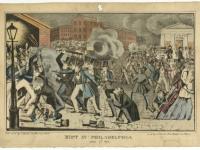In this lesson, students examine the case of the 1844 anti-Irish riots in Philadelphia. Drawing on a variety of sources and first person accounts of the incident, students discuss point of view in historical narrative and generate their own narrative account of the riots.
Reporting Ethnic Violence
Reporting Ethnic Violence
Essential Questions
Objectives
- Students will understand the factors that led to anti-immigrant sentiment and nativist activities in the 19th century.
- Students will formulate conclusions as to how and why nativist ideologies grew in Pennsylvania in the early 19th century.
- Students will present a comprehensive work displaying their understanding of the 1844 Riots in Pennsylvania.
Other Materials
The primary resources for this lesson are not yet available in our digital library. However, the following links provide PDF versions of all primary sources used in this lesson.
Reflections on the Late Riots by Candid Writers in Poetry and Prose. Philadelphia: 1844.
Kensington Riots
The Catholic Herald: Thursday, May 9, 1844
"The Kensington Massacre" The Republic, A Magazine for the Defense of Civil and Religious Liberty, No. 1 August 1845.
Southwark Riots
The Catholic Herald: Thursday, July 11, 1844
Official Testimony of Sheriff Morton McMichael and General Cadwalader from The Olive Branch; or, An Earnest Appeal in Behalf of Religion, The Supremacy of law, and Social Order: With Documents relating to the Late Disturbances in Philadelphia. Philadelphia 1844.
Background Readings:
- City of Unbrotherly Love: Violence in Nineteenth-century Philadelphia
- Images of the 1844 Riots
- FREEDOM OF RELIGION: Bibles, Public Schools, and Philadelphia's Bloody Riots of 1844
Student Worksheet: Reading the Riots
Suggested Instructional Procedures
1. Set the 1844 riots in the political, social, and economic context of the period. Points teachers should emphasize include: the rise of the “Know-Nothings” and the Native American party, structural change in the American economy, rapid growth of population and industry in Philadelphia, the ethnic make-up of Philadelphia in 1844, the rising tide of Irish immigration to US and Pennsylvania.
Teachers should stress with students that nativism, negative attitudes toward immigrants, is often catalyzed by other things happening in the society at the time. That is, immigrants are often convenient scapegoats when people feel the negative effects of dramatic changes. The causes of nativism are often complex. Although nativism takes a specific form in each era, there are also general patterns that frequently manifest themselves. Teachers should encourage students to look both at the content of these sentiments, and at their context -- the underlying factors that tend to catalyze negative feelings toward immigrants.
There are three primary lenses through which anti-immigrant sentiment is often refracted, but these are not exclusive of one another:
- Cultural/racial – fears or anxieties about perceived cultural, linguistic, religious or racial differences, concerns about demographic change. Anxiety about difference: racial, religious, cultural, linguistic: nativists view immigrants as fundamentally different and dangerous to the American norm, fragmentation, fears of a non-white majority.
- Economic -- economic change and instability during which immigrants become the lightening rod for fear or discontent. Economic change: immigrants are scapegoated for the loss of status or security of American workers, usually due to some larger structural change in the economy (industrialization, de-industrialization).
- Political/ideological – xenophobia or scapegoating of immigrants as a reaction against US global involvements or domestic civil unrest. Fears that foreigners will undermine American democracy (papism, monarchism, fundamentalism. Fears of violence (terrorism, activism).
2. Hand out the materials packet (including primary source documents) so that the class has a general idea of how the riots began. Students will examine the primary accounts of the 1844 riots in Philadelphia to understand the chain of events. Using the worksheet, have students analyze an account individually or in small groups. Discuss each account and situate it within the time. Who is the writer (Protestant, Catholic, Irish, etc)? How do they feel about the Irish (negative, sympathetic)? What values seem important to them?
3. Divide students into small groups to role-play as the staff of the Philadelphia Daily Ledger, a fictional 19th century newspaper in Philadelphia, charged with reporting on the Philadelphia riots of 1844. Task each group with producing an issue of the paper for late July 1844. Each group represents a newspaper staff group and each member accepts a staff position with the following assignments:
- Staff reporter(s): write a blow-by-blow account of the riots, including a description of what happened, mock interviews with major players (rioters, police/militia, Irish parishioners)
- Editor: write an op-ed piece condemning or supporting the violence, with reasons why they offer this position.
- Photographer/Illustrator: create images of the riots and their aftermath and/or use image handout and couple these images with the appropriate articles. Develop appropriate captions.
- Citizen letter to the editor: write a letter from an outraged citizen supporting or condemning the paper’s editorial stance and offering an alternative view. Multiple letters might be submitted in order to capture the perspective of a Native American party member, an Irish Catholic immigrant, or a police/military volunteer.
- After each student selects their role, they should discuss the details of the newspaper’s layout. What will be the column size, font, etc.? After students have written a rough draft and peer edited their work, they should type their final draft according to the standards they agreed upon and assemble the paper in class.
4. Have students share their newspapers across each group and compare them.
5. Discuss:
- How do the editorials and accounts reflect the attitudes of the day?
- How well did each group capture the feeling and attitudes of the past?
- How would an event like the riots be covered in the media today?
Vocabulary
Discrimination: Unfair treatment of a person or group (either intentional or unintentional) based on race, color, national origin, religion, sex, handicap, or other attribute.
“Know Nothings”: A secret fraternal organization which sought to curtail the political power of Catholics and immigrants, probably derived its name from its members' pledge to feign ignorance if queried about the group.
Native American Party, or American Party: Political party formed in the 1850s that advocated for the limitation of Immigration, restrictions on political office and citizenship for non native-born Americans, in addition to temperance and anti-Catholic measures in public schools.
Nativism: Anti immigrant sentiment, or a sociopolitical policy favoring the interests of established inhabitants over those of immigrants. Historically refers to white, native-born, Protestant Americans' hostile and defensive reaction to European immigrants.
Racism: Prejudice or discrimination based on an individual's race; can be expressed individually or through institutional policies or practices. Racism is a system of oppression. It is a nexus of racist beliefs, whether explicit, tacit or unconscious; practices; organizations and institutions that combine to discriminate against and marginalize a class of people who share a common racial designation, based on that designation.
Riot: Public act of disorder involving group violence.
Stereotype: Ethnic stereotypes are fixed, oversimplified ideas about an entire group. A stereotype may contain a "kernel of truth," but this kernel becomes exaggerated and rigidly applied to the entire group.

Plans in this Unit
Grade Level
Duration
Standards/Eligible Content
About the Author
This lesson was created by Kathryn Wilson. Updated for SAS by Casey B. Wernick and Amy Seeberger, Education Interns, Historical Society of Pennsylvania.
Attention Teachers!
Let us know how you used this plan and be featured on our site! Submit your story here.


